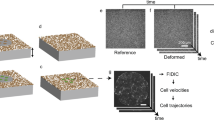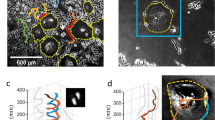Abstract
THE mechanism of amoeboid movement in general, and more specifically that of tissue cells such as fibroblasts, is controversial and unknown. Most theories state that cell movement involves active changes in cell shape, brought about by forces generated by metabolic energy, such as pseudopod formation and withdrawal, but there is no agreement about the site and nature of the forces involved1. In marked contrast to such theories, the recent theory put forward by Carter2 for tissue cells suggests that cell motility is essentially a passive phenomenon wherein net forces are generated by asymmetric surface tension type forces at the interfaces between cell, substratum and surrounding medium. To test this theory for tissue cells a simple series of experiments has been carried out on the effect of temperature on the spreading and rounding up of cells. Most tissue cells, such as fibroblasts, when freed from contact with other cells or other solid substratum and maintained in suspension, become more or less rounded3,4. When they are allowed to settle on a solid surface they tend to flatten on it; the question is whether this is brought about by active cellular processes or whether it is a passive phenomenon due to surface tension forces as Carter suggests. If cell spreading were caused by passive spreading, it ought not to be significantly affected by lowered temperature, which does, however, considerably reduce active cell movement.
This is a preview of subscription content, access via your institution
Access options
Subscribe to this journal
Receive 51 print issues and online access
$199.00 per year
only $3.90 per issue
Buy this article
- Purchase on Springer Link
- Instant access to full article PDF
Prices may be subject to local taxes which are calculated during checkout
Similar content being viewed by others
References
Wolpert, L., Symp. Soc. Gen. Microbiol., 15, 270 (1965).
Carter, S. B., Nature, 213, 256 (1967).
Curtis, A. S. G., The Cell Surface (Academic Press, New York, 1968).
Gustafson, R., and Wolpert, L., Biol. Rev., 42, 442 (1967).
Macpherson, I., and Stoker, M., Virology, 16, 147 (1962).
Weiss, L., Exp. Cell Res., 33, 277 (1964).
Ingram, V. M., Nature, 222, 641 (1969).
Author information
Authors and Affiliations
Rights and permissions
About this article
Cite this article
WOLPERT, L., MACPHERSON, I. & TODD, I. Cell Spreading and Cell Movement: an Active or a Passive Process?. Nature 223, 512–513 (1969). https://doi.org/10.1038/223512a0
Received:
Issue Date:
DOI: https://doi.org/10.1038/223512a0
This article is cited by
Comments
By submitting a comment you agree to abide by our Terms and Community Guidelines. If you find something abusive or that does not comply with our terms or guidelines please flag it as inappropriate.



